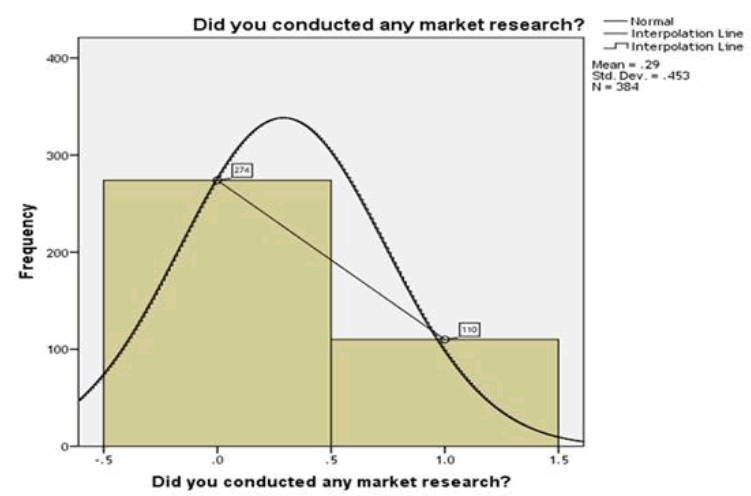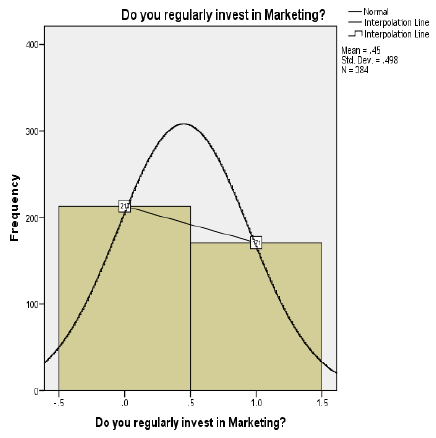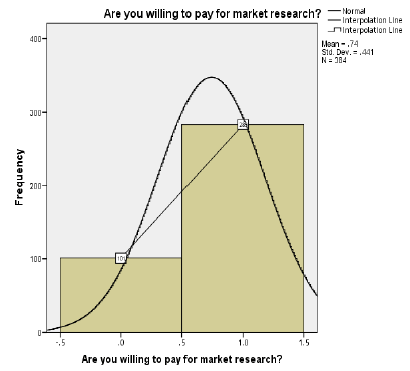Research Article: 2022 Vol: 21 Issue: 6S
Market Research Affects the Planning of Human Resource Education and Influences the Growth of Local Economic Development-Study Case in Kosovo
Agim Zuzaku, University for Business and Technology
Liridon Dalipi, University of Kadri Zeka
Citation Information: Zuzaku, A., & Dalipi, L. (2022). Market research affects the planning of human resource education and influences the growth of local economic development – Study case in Kosovo. Academy of Strategic Management Journal, 21(S6), 1-9.
Keywords
Economic Development, Education, Labor Market, Market Research, Human Resources
Abstract
The supply and demand of the labor market have a huge discrepancy in Kosovo. The unemployment rate in Kosovo is 27.5%, while the Youth unemployment rate (15-24 years) is 52.4%. On the other side, businesses do not have enough workers and the demand for labor is extremely high (Kosovo Agency of Statistics, 2015).
One of the factors influencing this supply and market demand discrepancy is the lack of HR planning by profession and the recommendation for directions or profiles in educational institutions.
In Kosovo, unemployment is high, while businesses are looking for workers. The public sector is the Sector that employs the largest number of employees.
The objective of this paper is to research the labor market, harmonize the supply and demand of the workforce by profession, and influence local economic development.
Based on the conclusions of this research, all curricula in the faculty should be reviewed and greater importance is given to vocational schools to harmonize the supply and demand of the workforce.
Introduction
Local Economic Development in the Republic of Kosovo is based on Article 17 of the Law on Local Self-Government. Municipalities have full and exclusive competencies in terms of local interest, where precisely the area of local economic development is defined in point a) of this article.
Also, Article 58, item i) of the Law on Local Self-Government, the municipal mayor's responsibility is the municipal development proposal. Referring to the above-mentioned legal hazards, we can freely say that to have sustainable economic development in Kosovo, there is a need for local economic development.
In this context, building policies at the local level is a prerequisite for the general well-being of citizens. In general, almost all municipalities have strategies for local economic development based on the priorities of each municipality. Therefore, knowing the importance of this area, municipalities are making efforts through local economic development to improve and enhance the quality of life of citizens by creating new opportunities in economic and social well-being.
To achieve these goals, municipalities have a particular focus on improving and developing local infrastructure, creating appropriate development conditions, promoting small and medium-sized local businesses, promoting the creation of new jobs through investment in new from the country, as well as from abroad.
Municipalities are responsible for creating a climate and a favorable business environment for local economic development. To have a local economic development, it is obvious that there should be a comprehensive and well-built policy at the local level, where various and clear programs, which are divided according to respective fields, will be developed starting from: investing in human resources, preserving and advancing existing businesses, attracting new businesses, planning and designing investment areas, providing a safe and convenient environment for foreign direct investment, adopting moderate technologies, managing resources and exploitation of unpopulated land, as well as many other factors that influence and are determinant in local economic development.
In this regard, the drafting of clear and concrete policies, as well as the strategic planning process for local economic development, could be achieved through a common working culture among people and the formation of long-term partnerships. Also, these essential elements would enable sustainable economic growth, where economic benefits, the improvement of living conditions, and the quality of life of all citizens would be crucial and visible, regardless.
The Government Program of the Republic of Kosovo focuses on five main pillars; Sustainable economic development, employment, and well-being: the rule of law and the rule of law; European agenda and foreign policy; education, science, culture, sports, and youth development; and modem health.
This work explores the role and importance of market research in Kosovo based on the need for market research and marketing to influence the effective management of businesses.
The development of a business depends on the strategy and the possession of information that has. To take appropriate decisions, we should have the right information. Providing appropriate information accomplished through marketing research in this aspect is part of the marketing process (Kent, 2007). Often we cannot distinguish the term "marketing research" from "market research", causing much confusion in terms of what these terms mean. Author Tony Proctor in his book "Essentials of Marketing Research", has explained that the term market research is only one element of marketing research, which includes the full range of activities of research and evaluation undertaken by marketing professionals, for a guide then, in taking decisions (Proctor, 2005). Therefore, to be more understanding we will treat only market research as a marketing research activity that needs to be part of any business strategy.
Purpose and Objectives of the Study
The main aim of this thesis is to explore possibilities of local economic development through market research and to harmonization the supply and demand of the workforce. The research aims to test several variables that affect the municipalities to do the market research of the supply of workforce and to see the demand of businesses.
The main question the study raises is: Does Market Research Affect Local Economic Development? This thesis will be explored primarily through the prism of local government decision-making and the impact of research on local economic development.
The hypothesis of this study is: Market research affects local economic development by harmonizing supply and demand for human resources.
Market research often spreads consultancy, generating ideas, or solving problems. Good research often includes all these elements. This is also a time of change for the market research industry and for this reason, it is difficult to determine its limits clearly (Keegan, 2009).
Methodology
The study was conducted through quantitative methods, which are collected and processed data from interviews of business activities: production, service, and trading,through a representative sample, where the sample population, will be the register of business registration in Kosovo. Interviewing was conducted face to face with the owners or managers of businesses through a structured questionnaire. Sample selection was random. Data analysis and processing are carried out through SPSS.
We use the method of face-to-face interviewing because it has several comparative advantages from other techniques. Every survey method used has limitations, and the use of face-to-face interviews for data collection is no exception. Though it is the oldest method, face-to-face interviews are widely used for data collection. There are also well-tested techniques for designing questions for these interviews.
The first rule we use to design the questionnaire is to fit the chosen method. Since we usually use the face-to-face/personal interviewing technique we try not to undermine the personal character of the sample unit, goals of the project, and other factors.
The other rule is to keep the questionnaire as short and simple as possible. More people will complete a shorter questionnaire, regardless of the interviewing method. If a question is not necessary, we do not include it.
We start with an introduction or thanking the respondent for taking the time to answer our questions. Then, the interviewer states who we are and why we want the information in the survey, encouraging the people to complete your questionnaire.
Materials and Methods
I. Cochran's sample size formula for categorical data for an alpha level a priori at .05 (error of 5%) = n0=(t)2*(p)(q)/(d)2=384
Where: n0 is the sample size, t is the value for the selected alpha level, e.g. 1.96 for (0.25 in each tail) a 95 percent confidence level. p is the estimated proportion of an attribute that is present in the population. q is 1-p. (p)(q) is the estimate of variance. d is the acceptable margin of error for proportion being estimated, so the confidence interval, in decimals.
II. Cochran’s correction formula, when pop. <50.000 is: n1 = 384/(1+384/528)= 222
Where: population size =528 Where n0 = required return sample size according to Cochran’s formula= 384 Where n1 = required return sample size because sample > 5% of population (Cochran, 1977).
The study was conducted through quantitative methods, which are collected and processed data from interviews of business activities: production, service, and trading, through a representative sample with a confidence level of 95% and confidence interval of 5, where the sample population, was the register of business registration in Kosovo.
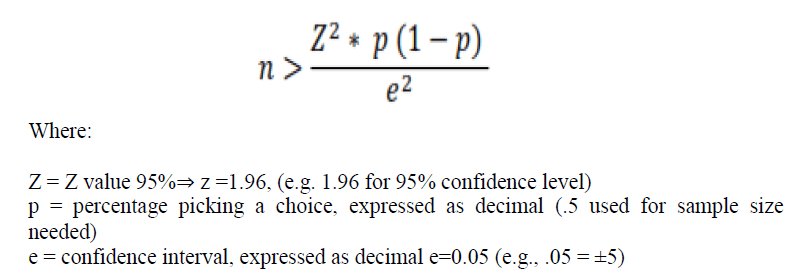

Categorical Data
The sample size formulas and procedures used for categorical data are very similar, but some variations do exist. Assume a researcher has set the alpha level a priori at .05, plans to use a proportional variable, has set the level of acceptable error at 5%, and has estimated the standard deviation of the scale as .5. Cochran’s sample size formula for categorical data and an example of its use are presented here along with explanations as to how these decisions were made.
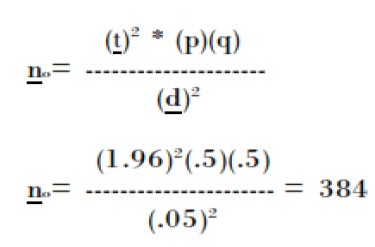
Where t = value for selected alpha level of .025 in each tail = 1.96.
(The alpha level of 0.05 indicates the level of risk the researcher is willing to take that true margin of error may exceed the acceptable margin of error).
Where (p)(q) = estimate of variance = 0.25.
(Maximum possible proportion (0.5) * 1- maximum possible proportion (0.5) produces maximum possible sample size).
Where d = acceptable margin of error for proportion being estimated = 0.05 (Error researcher is willing to accept).
Therefore, for a population of 1,679, the required sample size is 384. However, since this sample size exceeds 5% of the population (1,679*.05=84), Cochran’s (1977) correction formula should be used to calculate the final sample size. These calculations are as follows:
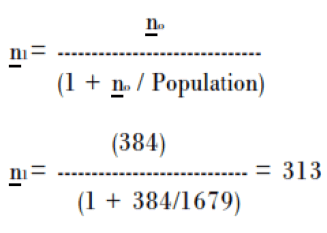
Where population size = 1,679
Where n0 = required return sample size according
To Cochran’s formula= 384
Where n1 = required return sample size because
Sample > 5% of population
These procedures result in a minimum: A returned sample size of 313. Using the same oversampling procedures as cited in the continuous data example, and again assuming a response rate of 65%, a minimum drawn sample size of 482 should be used. These calculations were based on the following:
Where anticipated return rate = 65%.
Where n2 = sample size adjusted for response rate.
Where minimum sample size (corrected) = 313.
Therefore, n2 = 313/0.65 = 482
The minimum sample size would be 384 (Bartlett, Kotrlik, & Higgins, 2001) of businesses from 130,742 that are registered in the Kosovo Business Registration Agency (Kosovo Business Registration Agency, 2018).
Interviewing was conducted face to face with the owners or managers of businesses through a structured questionnaire. Sample selection was random. Data analysis and processing are carried out through SPSS.
Results
Descriptive statistics were used to analyze the socioeconomic features of businesses while the Binary Logistic Regression model was used to capture the factors determining businesses’ willingness to pay for Marketing Research. The research has been focused on the annual income of businesses, investment in marketing, market research realization by businesses, and their willingness to make decisions from market research and willingness to pay for market research services.
As shown in Figure 1, only 28.6 percent of businesses surveyed have conducted market research. Meanwhile, 71.4 percent have never conducted market research.
| Table 1 Results Of Market Research |
|||||
|---|---|---|---|---|---|
| Did You Conduct Any Market Research? | |||||
| Frequency | Percent | Valid Percent | Cumulative Percent | ||
| Valid | No | 274 | 71.4 | 71.4 | 71.4 |
| Yes | 110 | 28.6 | 28.6 | 100.0 | |
| Total | 384 | 100.0 | 100.0 | ||
In Figure 2 we see that more than half of businesses or 55.5 do not invest regularly in marketing. While only 44.5 percent of them invest regularly and have a contract with marketing companies.
| Table 2 Results Of Investing In Marketing |
|||||
|---|---|---|---|---|---|
| Do you regularly invest in Marketing? | |||||
| Frequency | Percent | Valid Percent | Cumulative Percent | ||
| Valid | No | 213 | 55.5 | 55.5 | 55.5 |
| Yes | 171 | 44.5 | 44.5 | 100.0 | |
| Total | 384 | 100.0 | 100.0 | ||
Figure 3 shows that 73.3 percent declared that are willing to pay for market research services. In the table below in the description of the statistics, is seen that only 3 percent of businesses surveyed have invested in marketing.
| Table 3 Results Of Willingness To Pay For Mr |
|||||
|---|---|---|---|---|---|
| Are you willing to pay for market research? | |||||
| Frequency | Percent | Valid Percent | Cumulative Percent | ||
| Valid | No | 101 | 26.3 | 26.3 | 26.3 |
| Yes | 283 | 73.7 | 73.7 | 100.0 | |
| Total | 384 | 100.0 | 100.0 | ||
Conclusion
From this research, we conclude that the number of companies in Kosovo that invest in market research is insufficient to have a business development in general. Although most of them have stated that you are willing to pay for market research, it is not proven in practice. Also, a small percentage of only 3 percent of the average investment of surveyed companies that invest in marketing, has led to the Kosovo number of businesses failing to reach the 22% registered in 2015 (Statistical Agency of Kosovo, 2014).
Based on the findings of our research we can conclude that the number of market research is very small about businesses that conduct their activities in Kosovo and as a result of unrealized market research we have the cessation of many businesses, or we do not have any business development.
We may also conclude that the investment in market research, increases in number of jobs. This was argued by the number of existing businesses of 130 742 if 10% of their businesses are divided as developed 13074, and assume that only half of them will realize a market research per year, will have 6537 businesses possible. When we divide the number of businesses that offer market research services in Kosovo falls 50 research on a company within the year. If we take an average number of 20 researchers engaged in the field we would have about 1,000 new employees in businesses that deal with market research. However, to influence the development of businesses in general market research should be accompanied by new investments in advanced technology.
We recommend that the Government of Kosovo invest more in raising awareness among businesses for market research. Also, donors to pay attention to market research during the development of programs for the development of businesses in Kosovo. And special attention is given course to market research in higher education institutions since it is a good basis for future market research knowledge to be applied in practice.
References
Administrata Tatimore e Kosovës (Tax Administration of Kosovo). (2014). Bizneset e çregjistruara pas kërkesës së tatimpaguesit. Prishtinë, Kosovë, Kosovë. (Businesses deregistered at the request of the taxpayer. Pristina, Kosovo, Kosovo)
Administrata Tatimore e Kosovës (Tax Administration of Kosovo) (2014). Lista e bizneseve pasive. Prishtinë, Kosovë, Kosovë. (List of passive businesses. Pristina, Kosovo, Kosovo.)
Agjencia e Regjistrimit të Bizneseve në Kosovë (Kosovo Business Registration Agency) (2014). Llojet e bizneseve sipas Komunave. Prishtinë: Agjencia e Regjistrimit të Bizneseve në Kosovë.
Agjensioni i Regjistrimit të Bizneseve në Kosovë. (2014). Databaza e Rexhistrimit të Bizneseve në Kosovë.
Cupman, J. (2014). The role of market research in decision making.
D.Sachs, J. (2005). The end of Poverty: Economic possibilities for Our Time.
Crossref, GoogleScholar, Indexed At,
ESOMAR Industry Report. (2013). Global Market Research. Amsterdam, The Netherlands: ESOMAR.
FAO. (1997). Marketing research and information systems. (Marketing and Agribusiness Texts - 4). Rome: Food and agriculture organization of the United Nations regional office for Africa.
Graves, P. (2010). The market research myth, the Truth about Consumers and the Psychology of shopping. London; Boston: Nicholas Brealey Publishing.
Green, P.E., Tull, D.S., & Albaum, G.S. (1993). Research For Marketing Decisions (5th Edition). New Delhi: Prentice-Hall.
Crossref, GoogleScholar, Indexed At,
Keegan, S. (2009). Qualitative research: good decision making through understanding people, cultures, and markets. London, Philadelphia: Kogan Page Limited.
Crossref, GoogleScholar, Indexed At,
Kent, R. (2007). Marketing Research: Approaches, Methods, and Applications in Europe. London: Thomson Learning.
Knight, J. (2010). Just how much do the big companies spend on consumer research.
Kotler, P. (2002). Marketing Management Millenium Edition. New Jersey: Pearson Custom Publishing.
Crossref, GoogleScholar, Indexed At,
Kotler, P., & Armstrong, G. (2012). Principles of Marketing, 14. New Jersey: Pearson Education, Inc.
Crossref, GoogleScholar, Indexed At,
Kotler, P., & Caslione, J.A. (2009). Chaotics: The Business of Managing and Marketing in the Age of Turbulence. New York: American Management Association.
Crossref, GoogleScholar, Indexed At,
Kotler, P., & Pfoertsch, W. (2006). B2B Brand Management. Heidelberg, Germany: Springer.
Crossref, GoogleScholar, Indexed At,
Lusk, J.L., & Shogren, J.F. (2007). Experimental auctions: Methods and applications in economic and marketing research. Cambridge, United Kingdom: Cambridge University Press.
Crossref, GoogleScholar, Indexed At,
Malhotra, N.K. (2008). Review of Marketing Research. 4. Armonk, New York; London, England: M.E.Sharpe, Inc.
Crossref, GoogleScholar, Indexed At,
McFadden, D. (1997). Measuring willingness to pay for transportation improvements. Berkeley: Department of Economics, University of California.
Crossref, GoogleScholar, Indexed At,
Proctor, T. (2005). Essentials of Marketing Research (4th Edition). Harlow, England: Pearson Education Limited.
Qd Friends Internationale. (2012). Qd Friends Internationale. Qd Friends Internationale WordPress.
Robbins, S.P., & DeCenzo, D. (2012). Bazate menaxhimit: Koncepte th aplikime themelore. Tirana: UET Press.
Simonic, M., Dumicic, K., & Devetak, G. (2012). Regression Analysis of variables Describing Poultry Meat Supply in European Countries. Research papers, 289-299.
Crossref , GoogleScholar, Indexed At,
Szwarc, P. (2005). Researching customer satisfaction and loyalty. London; Sterling, VA: Kogan Page.
Crossref, GoogleScholar, Indexed At,
Victor, P., & Franckeiss, A. (2002). The five dimensions of change: an integrated approach to strategic organizational change management. Strategic Change, 35–42.
Crossref, GoogleScholar, Indexed At,
Wardle, J. (2002). Developing Advertising with Qualitative Market Research. London: SAGE Publications Ltd.
Crossref, GoogleScholar, Indexed At,
Zuzaku, A. (2014). Marketing research is path towards the development of agriculture in Kosovo. Economic and Social Development, 8th International Scientific Conference on Economic and Social Development and 4th Eastern European ESD Conference: Building Resilient Economy (pp. 488-496). Zagreb: Varazdin Development and Entrepreneurship Agency in cooperation with University North.
Zuzaku, A. (2015). The significance of market research to businesses. Advances in business management. Towards Systemic Approach 3rd Business systems Laboratory International Symposium- Perugia, 2015 (p. 369). Perugia, Italy: Business Systems Laboratory.
Received: 04-Mar-2022, Manuscript No. ASMJ-22-11443; Editor assigned: 07- Mar -2022, PreQC No. ASMJ-22-11443 (PQ); Reviewed: 21- Mar - 2022, QC No. ASMJ-22-11443; Revised: 28-Mar-2022, Manuscript No. ASMJ-22-11443 (R); Published: 04-May-2022
